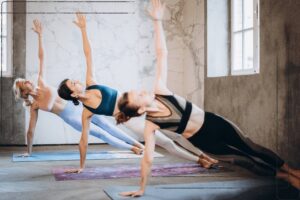The secrets of fitness with our in-depth exploration of “fasted cardio benefits.” Discover the nuances of exercising on an empty stomach and delve into the potential advantages of your weight loss journey. Unravel the science behind fasted cardio and decide if this unique approach aligns with your fitness goals.
What is fasted cardio?
This exercise modality unfolds when the body operates in a fasted state, abstaining from the ongoing process of food digestion. Essentially, it entails engaging in cardiovascular activities on an empty stomach.
Typically initiated in the early morning after an overnight slumber, fasted cardio can also unfold later in the day for adherents of intermittent fasting. Contrary to nonfasted counterparts, fasted cardio boasts claims of expediting fat loss. However, the veracity of such assertions remains inconclusive. Let’s embark on a more profound exploration.
Is fasted cardio a safe pursuit?
Broadly speaking, for individuals in good health, incorporating brief or moderately extended steady-state fasted cardio into one’s routine is likely benign. Nonetheless, venturing into prolonged or high-intensity workouts during a fasted state harbors risks associated with low blood sugar and dehydration. Manifestations may range from light-headedness and dizziness to trembling or, in extreme cases, loss of consciousness.
Do the Benefits of fasted cardio extend beyond its safety parameters?
The underlying principle suggests that by abstaining from food overnight and engaging in a morning workout, the body depletes its primary energy source glucose and resorts to utilizing stored fat for fuel. Existing research yields mixed results on the efficacy of this approach.
While certain studies indicate heightened metabolic performance post fasted exercise, a counter-narrative posits that consuming a meal before prolonged aerobic activities enhances performance. Although conclusive evidence is yet to materialize, fasted cardio touts time saving perks, particularly for those constrained by time, adherents of intermittent fasting, or individuals preferring a pre-meal workout.
Learn More: 10 Popular Beauty Hacks Dermatologists Want You To Avoid
Does fasted cardio contribute to weight loss?
The linchpin of weight loss resides in expending more calories than one consumes. The evidence concerning whether fasted cardio genuinely catalyzes fat loss is discordant. A study dividing twenty young females into groups one performing an hour of fasted steady-state cardio, the other engaged in nonfasted cardio revealed no discernible difference in weight loss or body composition.
Conversely, certain research supports fasted cardio’s propensity to heighten fat-burning mechanisms during a workout. Yet, a comprehensive review emphasizes that the disparity in total daily calorie expenditure within a 24-hour span is trivial.
Within the realm of weight loss, the pivotal role belongs to non-exercise activity thermogenesis (NEAT). NEAT accounts for roughly 15% of daily calorie expenditure, dependent on individual activity levels. Elevating daily movement, whether during fasted or non-fasted periods, emerges as a more impactful strategy for weight loss than a brief session of fasted cardio.
What are the risks of fasted cardio?
Despite its potential benefits, cognizance of associated risks is imperative. The endeavor may impede muscle-building processes, as insufficient carbohydrates prompt gluconeogenesis a conversion of protein into fuel diminishing protein availability for muscle reconstruction.
Performance hindrance looms large, particularly in the context of moderate or high-intensity workouts. Empty stomachs might deprive the body of requisite energy levels, presenting signs of low blood sugar and dehydration.
Who should exercise caution or abstain from fasted cardio?
Prudence dictates avoidance for individuals susceptible to medical conditions influenced by low blood sugar or blood pressure, as well as expectant mothers. Novices, embarking on their fitness odyssey, are advised to steer clear until a comprehensive understanding of their bodies is established.
Learn More: Benefits of Bikram Hot Yoga A Powerful Practice for Mind and Body
Are there guidelines governing the practice of fasted cardio?
For those in good health, the decision to incorporate fasted cardio remains a personal one. Acquaintance with hydration protocols before and during the session is foundational. Commence with low to moderate-intensity steady-state exercises such as walking, running, cycling, or elliptical routines spanning ten minutes initially.
Evaluate your response to gradually progress to a 30-minute regimen over time. Post-exercise, replenish with a balanced meal or snack rich in protein and carbohydrates. Reserve high-intensity workouts, demanding more than an hour, for periods devoid of fasted cardio. Incorporating low-intensity steady-state fasted cardio on multiple days is viable, complemented by one or two rest days.
In summation, whether cardio unfolds in a fasted state or not, its merits are indisputable for overall well-being. While the metabolic impact of fasted cardio awaits conclusive determination, its alignment with personal preferences or lifestyle makes it a viable consideration for those in good health. Feel free to explore this avenue if it resonates with your fitness journey.
FAQs:
Q1: What is fasted cardio?
A1: Fasted cardio involves engaging in cardiovascular activities on an empty stomach, occurring when the body operates in a fasted state, abstaining from the ongoing process of food digestion. It is typically initiated in the early morning after an overnight slumber, but can also occur later in the day for those practicing intermittent fasting.
Q2: Is fasted cardio a safe pursuit?
A2: Broadly speaking, for individuals in good health, incorporating brief or moderately extended steady-state fasted cardio into one’s routine is likely benign. However, venturing into prolonged or high-intensity workouts during a fasted state harbors risks associated with low blood sugar and dehydration, potentially leading to symptoms like light-headedness, dizziness, trembling, or, in extreme cases, loss of consciousness.
Q3: Do the benefits of fasted cardio extend beyond its safety parameters?
A3: Fasted cardio aims to deplete the body’s glucose stores overnight, prompting the utilization of stored fat for fuel during a workout. Research yields mixed results, with some studies suggesting heightened metabolic performance post fasted exercise. The approach may be beneficial for those constrained by time, adherents of intermittent fasting, or individuals preferring a pre-meal workout.
Q4: Does fasted cardio contribute to weight loss?
A4: While evidence on its efficacy for weight loss is discordant, some studies support fasted cardio’s potential to enhance fat-burning mechanisms during a workout. However, a comprehensive review suggests the disparity in total daily calorie expenditure within a 24-hour span is trivial. Daily movement, regardless of fasting status, remains a more impactful strategy for weight loss.




